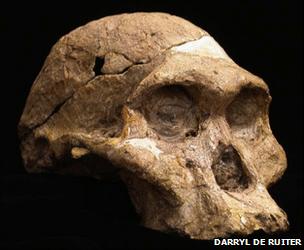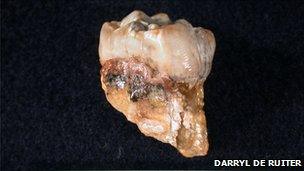Ancient cave women 'left childhood homes'
- Published

"Mrs Ples" is the most famous example of A. africanus from the Sterkfontein cave site
Analysis of early human-like populations in southern Africa suggests females left their childhood homes, while males stayed at home.
An international team examined tooth samples for metallic traces which can be linked to the geological areas in which individuals grew up.
The conclusion was that while most the males lived and died around the same river valley, the females moved on.
Similar patterns have been observed in chimpanzees, bonobos and modern humans.
Details of the study are published in a letter in Nature, external.
Isotopic test
The researchers looked at the Sterkfontein and Swartkrans cave sites, north-west of the South African city of Johannesburg.
The sites contain specimens of two distinct early "hominin" species, Australopithecus africanus, a possible direct ancestor of modern humans who lived around 2-3 million years ago, and Paranthropus robustus, who lived some 1.2-2 million years ago, but who is not believed to be our direct ancestor.
They took teeth from eight A.africanus and 11 P.robustus individuals from the cave sites, and removed tiny enamel fragments by laser, to minimise damage.
These fragments were then analysed to test for particular isotopes, or forms, of the metallic element strontium, which can reveal the geological region where individuals were raised.
This is because particular isotopes of strontium dominant within a geological region are digested by individuals living there and incorporated into their tooth enamel.

A third molar from Australopithecus africanus from which a sample was taken for the study
The results showed that the larger teeth, presumed to belong to males, showed most of these individuals lived and died in the region where the Sterkfontein and Swartkrans cave sites are located.
Most of the smaller teeth, presumed to be female, showed that these individuals grew up outside the region.
"What we were trying to do was to find out how these two hominins - two different species living in different time periods - were ranging around and using the landscape in the Sterkfontein valley and beyond," Professor Julia Lee-Thorp of Oxford University told BBC News.
While initial research was aimed at looking at seasonal variations in diet, the isotopic tests pointed them instead to apparent gender variations.
"What [the results] show was that the females were more likely to come from outside the dolomite valley region than the males. It wasn't too far away but it wasn't the same natal group in which they grew up.
"We don't know whether they drifted, or they went across deliberately, or they were abducted; we have no way of knowing that kind of detail, but on the whole most of the females came from somewhere else."
Professor Lee-Thorp said the patterns resemble those seen in chimpanzees, where males tend to stay within the extended family group, hunting together within a single territory, whereas females are forced to leave, possibly to avoid inter-breeding.
But that pattern differs from the one observed in gorillas, where a dominant "silverback" male usually mates with multiple females, and other males are forced to leave the group.
This does not mean, she believes, that the males within these hominin groups were necessarily taking any great role in child-rearing.
"I think that's taking the information too far, quite frankly," she said. "In chimpanzees that doesn't happen. In that case the females are leaving, but the males take little interest in nurturing the children."
Small sample
The sample size is of course very small, with specimens rare and samples for experimentation rarer. The researchers also admit that data from these two separate species living at two separate times was pooled to provide results which were statistically significant.
"We're very obviously constrained by the amount of material we have for destructive analysis," said researcher Professor Darryl de Ruiter of Texas A&M University, during a telephone conference dedicated to the Nature paper.
"In terms of comparing the two species themselves, we did analyse them separately but [the] sample size was so small within these individuals that they were not robust statistics... and we did have to combine these samples in order to get a valid statistical result."
Professor Peter Wheeler of Liverpool John Moores University said that both sample size and methodology were issues to consider.
"You've got to be cautious when drawing conclusions from a relatively small sample. You've got even greater concerns when combining data from more than one species," he said.
However, he said, "if the differences are consistent, then it's extremely interesting and worthy of further work".
He added: "Isotopic work is providing a lot of information about the movement of modern humans in the archaeological record and if people are able to get consistent results further back into prehistory, it could provide information which is potentially useful."